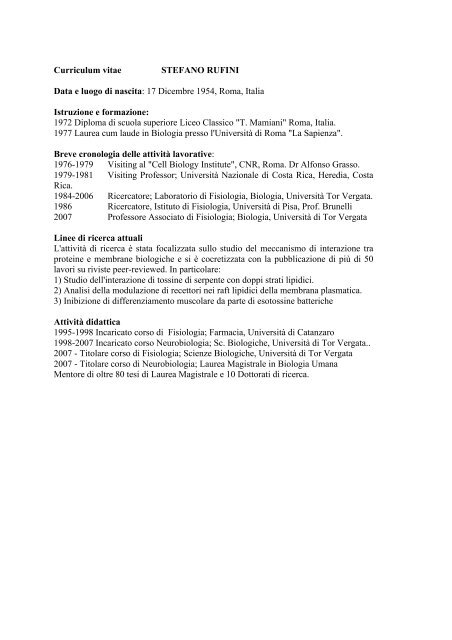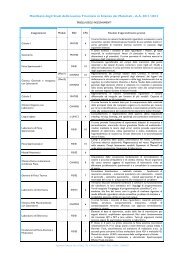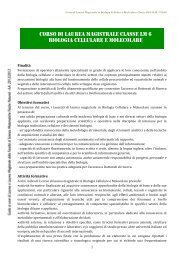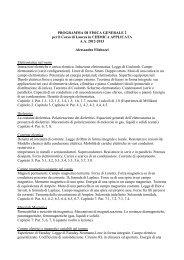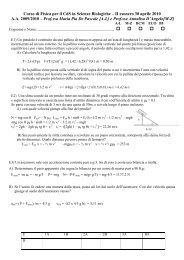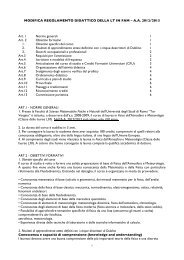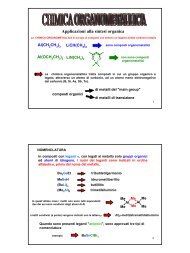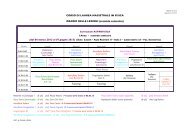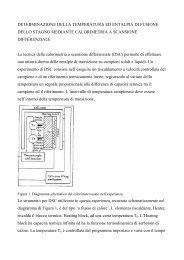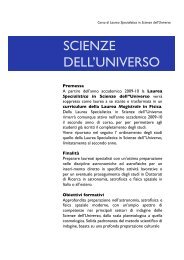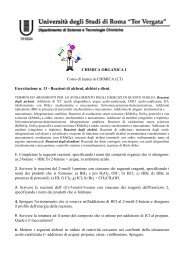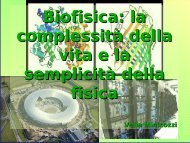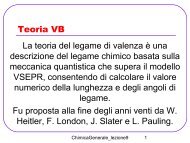Curriculum vitae STEFANO RUFINI Data e luogo di nascita: 17 ...
Curriculum vitae STEFANO RUFINI Data e luogo di nascita: 17 ...
Curriculum vitae STEFANO RUFINI Data e luogo di nascita: 17 ...
You also want an ePaper? Increase the reach of your titles
YUMPU automatically turns print PDFs into web optimized ePapers that Google loves.
<strong>Curriculum</strong> <strong>vitae</strong><br />
<strong>STEFANO</strong> <strong>RUFINI</strong><br />
<strong>Data</strong> e <strong>luogo</strong> <strong>di</strong> <strong>nascita</strong>: <strong>17</strong> Dicembre 1954, Roma, Italia<br />
Istruzione e formazione:<br />
1972 Diploma <strong>di</strong> scuola superiore Liceo Classico "T. Mamiani" Roma, Italia.<br />
1977 Laurea cum laude in Biologia presso l'Università <strong>di</strong> Roma "La Sapienza".<br />
Breve cronologia delle attività lavorative:<br />
1976-1979 Visiting al "Cell Biology Institute", CNR, Roma. Dr Alfonso Grasso.<br />
1979-1981 Visiting Professor; Università Nazionale <strong>di</strong> Costa Rica, Here<strong>di</strong>a, Costa<br />
Rica.<br />
1984-2006 Ricercatore; Laboratorio <strong>di</strong> Fisiologia, Biologia, Università Tor Vergata.<br />
1986 Ricercatore, Istituto <strong>di</strong> Fisiologia, Università <strong>di</strong> Pisa, Prof. Brunelli<br />
2007 Professore Associato <strong>di</strong> Fisiologia; Biologia, Università <strong>di</strong> Tor Vergata<br />
Linee <strong>di</strong> ricerca attuali<br />
L'attività <strong>di</strong> ricerca è stata focalizzata sullo stu<strong>di</strong>o del meccanismo <strong>di</strong> interazione tra<br />
proteine e membrane biologiche e si è cocretizzata con la pubblicazione <strong>di</strong> più <strong>di</strong> 50<br />
lavori su riviste peer-reviewed. In particolare:<br />
1) Stu<strong>di</strong>o dell'interazione <strong>di</strong> tossine <strong>di</strong> serpente con doppi strati lipi<strong>di</strong>ci.<br />
2) Analisi della modulazione <strong>di</strong> recettori nei raft lipi<strong>di</strong>ci della membrana plasmatica.<br />
3) Inibizione <strong>di</strong> <strong>di</strong>fferenziamento muscolare da parte <strong>di</strong> esotossine batteriche<br />
Attività <strong>di</strong>dattica<br />
1995-1998 Incaricato corso <strong>di</strong> Fisiologia; Farmacia, Università <strong>di</strong> Catanzaro<br />
1998-2007 Incaricato corso Neurobiologia; Sc. Biologiche, Università <strong>di</strong> Tor Vergata..<br />
2007 - Titolare corso <strong>di</strong> Fisiologia; Scienze Biologiche, Università <strong>di</strong> Tor Vergata<br />
2007 - Titolare corso <strong>di</strong> Neurobiologia; Laurea Magistrale in Biologia Umana<br />
Mentore <strong>di</strong> oltre 80 tesi <strong>di</strong> Laurea Magistrale e 10 Dottorati <strong>di</strong> ricerca.
<strong>Curriculum</strong> <strong>vitae</strong><br />
<strong>STEFANO</strong> <strong>RUFINI</strong><br />
Date and place of birth: December <strong>17</strong> th 1954; Roma, Italy<br />
Education and training :<br />
1972 Graduate from high school liceo classico “T. Mamiani” Roma, Italy.<br />
1977 Gratuated with full votation Doctor in Biology at the University of Roma.<br />
Brief chronology of Employment:<br />
1976-1979 Visiting at Cell Biology Institute, CNR, Roma. Dr Alfonso Grasso,<br />
1979-1981 Visiting Professor to National University of Costa Rica, Here<strong>di</strong>a, Costa<br />
Rica.<br />
1984-2006 Established Investigator, Department Biology, University of "Tor<br />
Vergata".<br />
1986 Research fellow, Institute of Physiology, University of Pisa, Prof Brunelli<br />
2007- Associate professor of Physiology for the Biology degree of Science of<br />
the University of Tor Vergata<br />
Current research lines<br />
The research activity was focused on the investigation of the mechanism of<br />
interaction between proteins and biological membranes that were object of more than<br />
50 paper in peer-review pubblication. In particular:<br />
1) Study of the interaction of toxins purified from snake venom with lipid bilayers.<br />
2) Analysis of modulation of membrane receptors by the lipid domains rafts.<br />
3) Inhibition of muscle <strong>di</strong>fferentiation by exotoxins purified by E. coli strains.<br />
Learning Activities<br />
1995-1998 Incharge of the course of Physiology for the Pharmacy degree of the<br />
University of Catanzaro, Italy<br />
1998-2007 Incharge of the course of Neurobiology for the Biology degree of Science<br />
of the University of Tor Vergata, Roma.<br />
2007 - Responsible of the Physiology course; Biological Sciences, University<br />
of Tor Vergata<br />
2007 - Responsible of the Neurobiology course; Biological Sciences,<br />
University of Tor Vergata<br />
Mentor of more than 80 Master thesis and 10 PhD programs.
Neurobiologia (Laurea Magistrale BEU)<br />
Programma del Corso<br />
Il sistema nervoso centrale: olismo e meccanicismo; Le aree <strong>di</strong> Brodmann; Meto<strong>di</strong> <strong>di</strong> stu<strong>di</strong>o<br />
dei deficit sensitivi-motori-cognitivi e mappatura del cervello. Memoria implicita e esplicita. I<br />
neuroni a specchio. Reti neurali. Hebb e la teoria delle mo<strong>di</strong>ficazioni funzionali degli elementi<br />
delle reti. Astrociti e regolazione del metabolismo dei neuroni. Il neurone: generalità,<br />
morfologia e strutture citoscheletriche. Trasporto degli RNA nei dendriti: loro repressione e<br />
attivazione. Il cono <strong>di</strong> crescita e la sinaptogenesi. Canali: patch clamp e meto<strong>di</strong> <strong>di</strong> stu<strong>di</strong>o. Il<br />
canale del potassio: struttura presunta, cancelli voltaggio <strong>di</strong>pendenti, specificità agli ioni. Il<br />
potenziale d'azione.La sinapsi: <strong>di</strong>fferenze tra sinapsi chimica e elettrica; il concetto <strong>di</strong><br />
secrezione regolata. La vescicola sinaptica: riempimento, veicolazione, <strong>di</strong>fferenti pool<br />
funzionali, ancoraggio, priming, rilascio, endocitosi. Recettori metabotropici e ioonotropici:<br />
<strong>di</strong>fferenze funzionali <strong>di</strong> localizzazione e strutturali. Localizzazione centrale e periferica dei<br />
neuroni colinergici, catecolaminergici e serotoninergici. La dopamina e il controllo dei<br />
movimenti: parkinson. Cocaina e Anfetamina e sistemi <strong>di</strong> trasporto delle catecolamine. LSD e<br />
serotonina. Il GABA e i suoi recettori. Glutamato e i suoi recettori: AMPA e kainato e<br />
NMDA. LTP e memoria nell'ippocampo. Danni ischemici e iperattivazione dei recettori<br />
NMDA. Kandel e l'appren<strong>di</strong>mento in Aplysia.<br />
Esami<br />
L'esame finale consiste in un colloquio orale<br />
Risultati <strong>di</strong> Appren<strong>di</strong>mento attesi<br />
Conoscenza dei meccanismi generali e dei principi molecolari alla base della memorizzazione<br />
e dell'appren<strong>di</strong>mento.
Neurobiology (MSc BEU)<br />
Program Course<br />
The central nervous system: mechanicism and holism. The Brodmann areas. Methods for the<br />
study of sensory-motor and cognitive deficits and brain mapping. Explicit and implicit<br />
memory. Mirror neurons. Neural networks. Hebb and the theory of functional changes of the<br />
networks elements. Astrocytes and regulation of metabolism of neurons. The neuron: general<br />
morphology and cytoskeletal structures. RNA transport in dendrites: their repression and<br />
activation. The growth cone and synaptogenesis. Methods of study the channels: patch-clamp.<br />
The potassium channel structure. The action potential. Synapse: <strong>di</strong>fferences between chemical<br />
and electrical synapses and the concept of regulated secretion. The synaptic vesicle: filling,<br />
conveying, <strong>di</strong>fferent functional pool, anchor, priming, release, endocytosis. Metabotropic<br />
receptors and ionotropic: functional localization and structural <strong>di</strong>fferences. Central and<br />
peripheral location of cholinergic, catecholaminergic and serotonergic neurons. Dopamine and<br />
movement control: the Parkinson <strong>di</strong>sease. Cocaine and Amphetamine and catecholamines<br />
transport systems. LSD and serotonin. GABA and its receptors. Glutamate and its receptors:<br />
AMPA and kainate and NMDA. LTP and memory in the hippocampus. Ischemic damage and<br />
overactivation of NMDA receptors. Kandel and learning in Aplysia.<br />
Examen<br />
The final exam consists of an oral interview<br />
Expected Learning Outcomes<br />
Knowledge of general mechanisms and principles of the molecular basis of memory and<br />
learning.
Fisiologia (Corso <strong>di</strong> Laurea <strong>di</strong> Primo Livello in Scienze Biologiche)<br />
Programma<br />
Il concetto <strong>di</strong> Omeostasi. I comparti dell'organismo, La membrana plasmatica: recettori e<br />
trasportatori. La Trasduzione del segnale. I potenziali <strong>di</strong> membrana: riposo, graduati e<br />
d'azione. La sinapsi. I recettori postsinaptici. Organizzazione generale del sistema nervoso<br />
centrale e periferico. Gli organi <strong>di</strong> senso. Il muscolo striato: struttura e funzione. La placca<br />
neuromuscolare. Il muscolo liscio. Il cuore: potenziali e vie <strong>di</strong> conduzione. Il ciclo car<strong>di</strong>aco.<br />
Arterie e Vene. La regolazione della pressione arteriosa. La coagulazione del sangue. La<br />
ventilazione polmonare. Gli scambi gassosi a livello polmonare e periferico. Funzioni renali:<br />
ultrafiltrazione, riassorbimento e secrezione. Escrezione e concentrazione dell'urina.<br />
Omeostasi <strong>di</strong> pH e osmolarità. Il sistema <strong>di</strong>gerente. Gli ormoni: ciclo mestruale, regolazione<br />
del metabolismo energetico, ormoni corticoi<strong>di</strong> e tiroidei.<br />
Esami<br />
L'esame consiste in una prova scritta (cinque domande a risposta aperta) e un colloquio orale.<br />
In alternativa all'esame scritto finale possono essere effettuati dal can<strong>di</strong>dato tre test in itinere<br />
(quin<strong>di</strong>ci domande a scelta multipla) che se superati danno <strong>di</strong>ritto a sostenere il colloquio<br />
orale.<br />
Risultati <strong>di</strong> Appren<strong>di</strong>mento attesi:<br />
Conoscenza dei meccanismi generali e dei principi molecolari alla base della fisiologia degli<br />
organi.
Physiology (Bachelor in Biological Sciences)<br />
Program<br />
The concept of homeostasis. The compartments of the body, The plasma membrane: receptors<br />
and transporters. The signal transduction. Membrane potentials: resting, graded and action.<br />
The synapse. The postsynaptic receptors. General organization of the central and peripheral<br />
nervous system. The sense organs. The striated muscle: structure and function. The<br />
neuromuscular junction. The smooth muscle. The heart: potential and conduction pathways.<br />
The car<strong>di</strong>ac cycle. Veins and Arteries. The regulation of blood pressure. The coagulation of<br />
the blood. Pulmonary ventilation. Gas exchange in the lungs and peripheral tissue. Kidney<br />
functions: ultrafiltration, reabsorption and secretion. Excretion and urine concentration.<br />
Homeostasis of pH and osmolarity. The <strong>di</strong>gestive system. Hormones: the menstrual cycle,<br />
regulation of energy metabolism; insulin, glucagon, thyroid hormones and corticoids.<br />
Exams<br />
The exam consists of a written test (five open-ended answer) and an interview.<br />
Alternatively to the written final examination, it can be carried out by the can<strong>di</strong>date three tests<br />
in progress (fifteen multiple choice questions) before the oral examination.<br />
Expected Learning Outcomes<br />
Knowledge of the general mechanisms and principles underlying molecular physiology of the<br />
organs.


